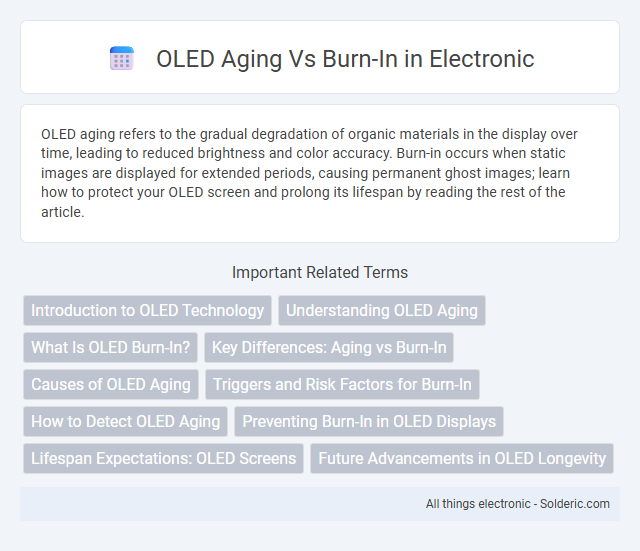OLED aging refers to the gradual degradation of organic materials in the display over time, leading to reduced brightness and color accuracy. Burn-in occurs when static images are displayed for extended periods, causing permanent ghost images; learn how to protect your OLED screen and prolong its lifespan by reading the rest of the article.
Comparison Table
| Aspect | OLED Aging | Burn-In |
|---|---|---|
| Definition | Gradual brightness and color degradation over time | Permanent ghost image from static content |
| Cause | Organic material wear with prolonged use | Extended display of static images causing uneven wear |
| Visibility | Overall screen dimming and color shift | Visible residual images or shadows |
| Reversibility | Partially reversible with rest and pixel shift | Mostly permanent, difficult to fix |
| Impact Timeframe | Long-term, occurs over thousands of hours | Short-term, noticeable after hours or days |
| Prevention | Use varied content and adjust brightness | Avoid static images; use screen savers and pixel shift |
| Common in | All OLED displays over extended use | OLED and AMOLED displays with static UI elements |
Introduction to OLED Technology
OLED technology utilizes organic compounds that emit light when an electric current passes through, offering vibrant colors and deep blacks. Over time, OLED panels experience aging, where materials gradually lose brightness and color accuracy, distinct from burn-in, which causes permanent image retention from static content. Understanding these differences helps you manage your display's lifespan and maintain optimal viewing quality.
Understanding OLED Aging
OLED aging refers to the gradual decline in brightness and color accuracy of organic light-emitting diodes over time due to the natural degradation of organic materials. This process differs from burn-in, which is a localized and permanent image retention caused by prolonged static content display. Understanding OLED aging involves recognizing its impact on display lifespan, performance consistency, and how usage patterns influence the rate of deterioration.
What Is OLED Burn-In?
OLED burn-in occurs when static images are displayed for extended periods, causing permanent discoloration or ghosting on the screen due to uneven pixel wear. This phenomenon differs from OLED aging, which is the gradual, uniform decline of pixel brightness over time affecting the entire display. Understanding burn-in helps you manage screen usage and settings to extend the lifespan and visual quality of your OLED device.
Key Differences: Aging vs Burn-In
OLED aging refers to the gradual decline in brightness and color accuracy over time due to organic material degradation, while burn-in is a localized, permanent image retention caused by static content displayed for prolonged periods. Aging affects the entire screen uniformly and occurs naturally with extended usage, whereas burn-in manifests as distinct ghost images or shadows in specific areas. Understanding these differences helps you manage display settings to prolong OLED lifespan and minimize visible damage.
Causes of OLED Aging
OLED aging primarily occurs due to the gradual degradation of organic materials used in the display, which leads to diminished brightness and color accuracy over time. The blue OLED emitters degrade faster than red and green ones, causing color shifts and uneven luminance. Factors such as high brightness settings, prolonged static image display, and elevated operating temperatures accelerate the aging process, impacting overall panel lifespan.
Triggers and Risk Factors for Burn-In
Burn-in on OLED screens occurs when static images are displayed for extended periods, causing uneven pixel wear. High brightness settings and prolonged exposure to UI elements such as navigation bars and logos significantly increase the risk of permanent image retention. Variations in organic compound degradation rates and uneven electrical current distribution are primary triggers contributing to accelerated OLED aging and burn-in susceptibility.
How to Detect OLED Aging
OLED aging can be detected by observing gradual color shifts and decreased brightness levels in the display over extended use. Patterns such as uneven luminance and subtle image retention during static content viewing indicate early stages of pixel degradation. Monitoring these visual changes helps differentiate normal aging from permanent burn-in effects in OLED screens.
Preventing Burn-In in OLED Displays
OLED burn-in occurs when static images cause uneven pixel wear, leading to permanent ghost images on the display. Preventing burn-in involves reducing static content display time, using screen savers, enabling pixel-shifting technology, and adjusting brightness levels to minimize stress on individual pixels. Regular calibration and allowing the screen to cycle through varying content help extend the lifespan of OLED displays and maintain image quality over time.
Lifespan Expectations: OLED Screens
OLED screen lifespan expectations typically range between 30,000 to 100,000 hours depending on usage and brightness settings. Aging in OLED displays results from gradual organic material degradation, causing reduced brightness and color accuracy over time. Burn-in occurs when static images persistently imprint on the screen, creating permanent ghost images, a risk mitigated by pixel-shifting technologies and varied content display.
Future Advancements in OLED Longevity
OLED aging primarily involves a gradual decrease in brightness and color accuracy over time, whereas burn-in is a localized and permanent retention of static images. Future advancements in OLED longevity focus on innovative materials and pixel-shifting technologies to minimize degradation and extend display life. These improvements ensure Your OLED devices maintain vibrant visuals longer, reducing the risk of noticeable burn-in and enhancing overall durability.
OLED Aging vs Burn-In Infographic

 solderic.com
solderic.com